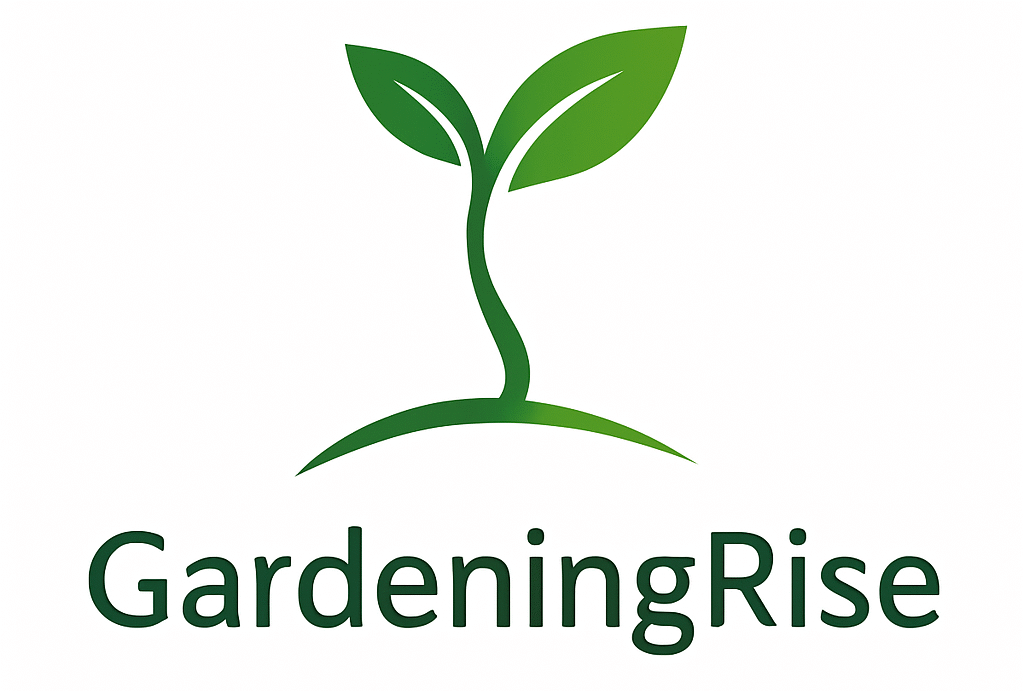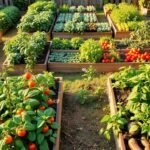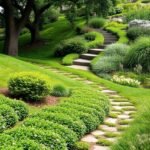Transform your outdoor space with elevated planting solutions that blend style and function. These structured growing areas create a sleek look while offering practical benefits like better soil control and easier maintenance. Clean lines and geometric shapes work seamlessly with today’s home exteriors, turning ordinary spaces into eye-catching features.
Contemporary approaches focus on simplicity, using materials like weathered steel or smooth cedar that improve with age. You’ll appreciate how these elements complement your existing landscape without overwhelming it. The result? A polished aesthetic that feels both intentional and effortless.
By prioritizing uncluttered layouts, you can achieve a balance between visual appeal and usability. Whether you’re growing herbs or arranging flowers, these setups keep your yard organized and accessible. Discover how thoughtful planning elevates your outdoor experience while reflecting current trends in residential spaces.
Discover the Advantages of Raised Garden Beds

Elevated planting setups bring more than visual appeal – they solve common challenges in small outdoor spaces. Whether growing herbs or vegetables, these structures give you precision over growing conditions while keeping maintenance manageable.
Improved Soil and Water Control
You decide what grows your plants. Unlike ground-level plots, you fill these beds with custom soil blends. This lets you:
- Eliminate poor drainage with loose, aerated mixes
- Balance nutrients for specific crops
- Prevent contamination from native clay or sand
Water behaves better too. Excess moisture drains quickly, protecting roots from rot. Early spring planting becomes possible since elevated soil warms faster than ground earth.
Ergonomics and Reduced Maintenance
No more kneeling or bending. The waist-high design lets you tend plants comfortably – perfect for those with mobility concerns. You’ll spend less time weeding because confined spaces discourage invasive grasses.
For small-space solutions, these beds maximize every inch. Their organized layout simplifies crop rotation and pest management, letting you focus on growth rather than guesswork.
Key Features and Functionality in Your Raised Garden Bed
Your garden deserves a setup that works as hard as you do, blending function with style. Thoughtful design elements transform simple planting areas into efficient, long-lasting growing spaces. Let’s explore how smart features protect your plants while elevating your yard’s overall look.
Optimized Drainage and Fertile Soil
Healthy roots start with proper drainage. Elevated setups let excess water escape quickly, preventing soggy soil that causes rot. Pair this with nutrient-rich blends tailored to your crops, and you’ll see faster growth and stronger yields.
Want to build your own raised bed garden? Focus on layering materials like gravel or sand beneath the soil. This simple step creates an environment where plants thrive, even during heavy rains.
Pest Deterrence and Enhanced Aesthetics
Ground-dwelling critters struggle to reach your plants in elevated beds. For extra protection, line the base with hardware cloth—it stops burrowing pests without blocking water flow. You’ll spend less time battling rabbits or rodents and more time enjoying your harvest.
The clean, structured look of these beds adds instant beauty to any space. Defined edges keep weeds contained, and the accessible height means no more bending over. It’s gardening made simple, stylish, and sustainable.
Modern Raised Garden Beds: Minimalist Designs for Contemporary Yards
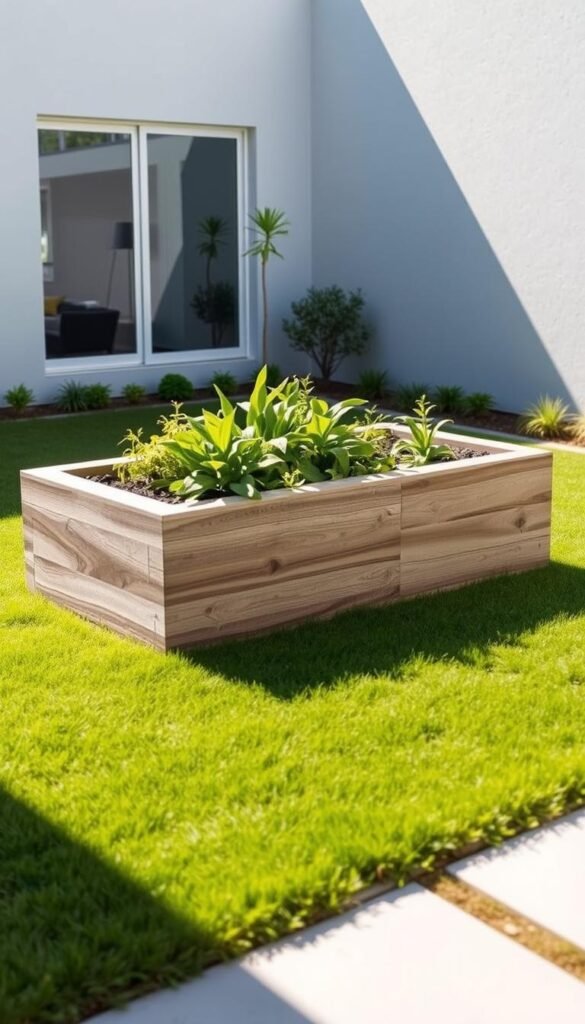
Sleek, structured growing spaces redefine how you interact with your landscape. These setups prioritize crisp angles and muted tones that align with today’s architectural trends. Materials like brushed steel or composite wood offer durability while keeping the design timeless – no fussy details required.
Neutral color schemes create harmony between your planting areas and patio furniture. Think charcoal grays, warm taupes, or matte blacks that let greenery take center stage. Geometric patterns – whether hexagonal tiers or floating rectangles – add visual rhythm without clutter.
Integrated features elevate practicality. Imagine benches doubling as bed edges or hidden compartments for tools beneath smooth planter ledges. Subtle solar lighting along the rim extends usability into evenings while maintaining that uncluttered look.
Choosing the right proportions matters most. Narrow rectangles suit tight walkways, while broad U-shaped configurations create intimate gathering spots. The goal? Spaces that feel curated yet effortless – where every element serves a purpose.
Innovative Materials for a Sleek Garden Look

The foundation of your outdoor oasis starts with material choices that balance form and function. Today’s options let you achieve polished aesthetics while addressing practical needs like durability and soil health.
Wood, Metal, and Concrete Options
Cedar stands out among wood choices. Its natural oils resist rot and insects, aging gracefully into a silvery-gray patina. Redwood offers similar benefits but comes at a higher price point. Avoid pressure-treated lumber for edible plants – safer alternatives exist.
Galvanized metal stock tanks bring industrial charm to your space. They’re surprisingly affordable for budget-friendly raised bed installations. Corten steel develops a protective rust layer, blending earthy warmth with modern lines.
Concrete blocks create bold geometric patterns. While durable, they may slowly alter soil acidity. Use them for ornamental plants or test your soil annually if growing edibles.
Natural and Recycled Material Choices
Recycled plastic lumber mimics wood’s texture without maintenance. It won’t splinter or fade, making it ideal for busy gardeners. For a rustic touch, try reclaimed barn wood – just ensure it’s untreated.
Did you know? Some metal raised beds use 80% recycled materials. This sustainable approach reduces waste while delivering sleek curb appeal.
Your final selection depends on climate, plant types, and desired maintenance. Prioritize materials that enhance your space’s character while supporting healthy growth season after season.
DIY Upcycled and Sustainable Garden Bed Ideas

Breathing new life into forgotten items adds character to your outdoor space while reducing waste. With a little creativity, everyday objects become functional planting solutions that tell a story. This approach lets you craft bed ideas that feel personal and eco-friendly.
Repurposing Old Furniture and Pallets
Start with wooden pallets – their slatted design naturally supports vertical gardens. Lean one against a wall, fill pockets with soil, and plant strawberries or trailing flowers. You’ll maximize vertical space while adding rustic charm.
Got an old dresser? Remove drawers and line them with landscape fabric. Fill each compartment with potting mix for herbs like basil or mint. The layered look creates instant visual interest. Pro tip: Use mismatched furniture pieces to design a quirky, cohesive display.
Reclaimed bricks offer flexibility. Stack them dry to form circular beds for tomatoes or peppers. Adjust the height as plants grow, or dismantle sections for seasonal changes. It’s one of the simplest bed ideas for dynamic layouts.
Don’t overlook bathtubs or wheelbarrows. Drill drainage holes, add gravel, and transform them into statement planters. While tires work for petunias or marigolds, avoid them for edibles. These ideas prove sustainability doesn’t sacrifice style – your space stays unique and earth-conscious.
Designing for Better Drainage and Soil Control
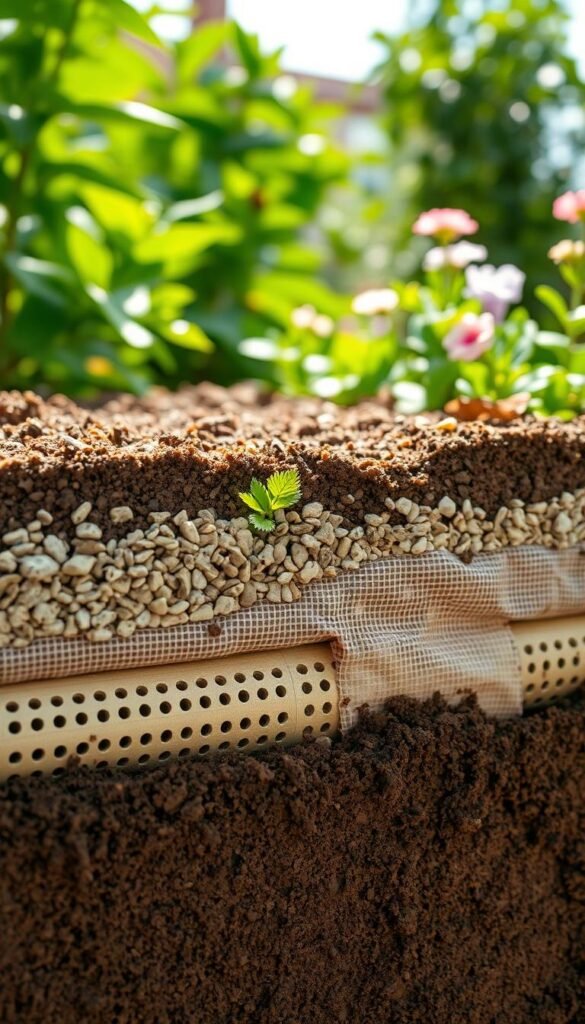
Smart drainage starts before the first seed goes in. Your plants’ success depends on what happens beneath the surface – a hidden world of air pockets and moisture balance. Proper layering creates self-regulating ecosystems where roots breathe easy and water moves efficiently.
Layering Techniques for Optimal Growth
Begin by drilling half-inch holes across your container’s bottom. Space them every 6-8 inches to let excess water escape. A base layer of pea gravel keeps these openings clear while creating an airy foundation. Pro tip: Broken pottery shards work too – they’re free and eco-friendly.
Landscape fabric comes next. This breathable barrier stops weeds but lets rainwater flow through. You’ll prevent soil loss during storms while keeping underground invaders out. One gardener swears: “My carrot harvest doubled after adding this simple layer.”
Build upward with yard debris like twigs and leaves. These chunky materials decompose slowly, creating natural drainage channels. As they break down, they feed your soil nutrients over time. Top it off with quality planting mix, leaving 18 inches for root expansion.
This tiered approach solves multiple problems at once. Your plants avoid soggy roots while accessing moisture during dry spells. You’ll spend less time watering and more time enjoying lush, healthy growth all season long.
Accessible and Ergonomic Outdoor Spaces
Gardening should welcome everyone, not strain your body. Elevated planting areas remove barriers by positioning plants at waist level, letting you nurture greenery without bending or kneeling. This approach transforms your space into an inclusive zone where comfort meets productivity.
Creating Raised Beds for Comfort and Ease
Customize your setup with heights ranging from 24 to 36 inches – ideal for reducing back stress. Wheelchair users appreciate the clearance beneath beds, allowing easy access to soil and plants. One gardener notes:
“Since switching to elevated beds, I can tend tomatoes for hours without soreness.”
Strategic layouts enhance flow. Position beds 3 feet apart to create natural walkways, letting tools and harvest baskets move smoothly through the area. Wider edges (6-8 inches) double as seating ledges, perfect for resting between tasks.
| Height Range | Best For | Accessory Features |
|---|---|---|
| 24-28″ | Standing gardeners | Tool hooks |
| 30-32″ | Seated work | Integrated benches |
| 34-36″ | Wheelchair access | Undercarriage clearance |
These designs do more than save your back. They turn your growing space into a social hub where friends and family gather comfortably. Wider beds (4 feet across) keep all plants within arm’s reach, eliminating awkward stretching.
By prioritizing ergonomics, you create a sustainable gardening practice. Reduced physical strain means longer, more enjoyable sessions in your outdoor area. Whether planting herbs or arranging flowers, every task feels effortless.
Stylish Raised Beds with Integrated Seating and Trellis Features
Imagine enjoying your morning coffee surrounded by thriving greenery. Built-in bench seating transforms your planting areas into inviting retreats where you can relax while tending crops. Wide cap rails double as casual perches, letting you pause and appreciate your garden’s progress.
Integrated trellis systems eliminate the need for separate supports. Train climbing plants like snap peas or clematis upward, creating living walls that save space. This approach works beautifully with square-foot gardening layouts, maximizing yields without crowding your yard.
| Material | Seating Feature | Plant Support |
|---|---|---|
| Cedar | 12″ wide ledges | Adjustable wire grid |
| Composite | Removable cushions | Built-in vertical slots |
| Powder-coated metal | Fold-down seats | Modular arch attachments |
Modular designs let you rearrange components as needed. Add extra seating for weekend gatherings or expand growing space for new crops. The clean lines maintain a polished look, even when bursting with blooms.
You’ll love how these setups create intimate garden rooms. Morning sunlight filters through bean vines while evening breezes carry floral scents to your seat. It’s practicality reimagined – where every element nurtures both plants and people.
Vertical Gardening Solutions for Compact Yards
Turn unused vertical areas into thriving gardens with smart stacking techniques. By growing upward instead of outward, you can cultivate herbs, vegetables, and flowers without sacrificing precious ground space. This approach works wonders for urban settings where every square foot counts.
Maximizing Space with Stacked Designs
Bamboo stands out as a versatile material for vertical systems. Its natural strength supports heavy crops like cucumbers, while its lightweight structure won’t overwhelm fences or walls. You’ll appreciate how quickly it blends into your yard’s aesthetic while decomposing naturally over time.
Try these strategies to boost productivity:
- Install tiered planters on sunny walls for herbs and strawberries
- Use hanging pockets for trailing flowers like petunias
- Train pole beans up bamboo trellises anchored in tall beds
One gardener shared:
“My 8-foot zucchini yield doubled after switching to stacked planters – all within a 3×3 foot corner!”
For those with small backyards, multi-level arrangements create depth and dimension. Wall-mounted containers keep pathways clear, while elevated beds with built-in trellises make harvesting at eye level a breeze. You’ll transform blank walls and narrow alleys into lush, edible landscapes.
Remember: balance light requirements when layering plants. Place sun-loving varieties at the top and shade-tolerant greens below. This thoughtful arrangement ensures every level thrives while making your space feel larger and more organized.
Utilizing Compact Designs for Urban Outdoor Areas
Small urban spaces can bloom with the right approach. Elevated planters turn cramped patios or balconies into thriving green zones. Even a concrete slab becomes productive when you use slim, rectangular containers that hug walls or railings.
Mobile units with wheels let you chase sunlight across your yard or balcony. Rotate crops seasonally by shifting planters from shady corners to sunny spots. This adaptability solves the challenge of fixed gardening areas in cities.
Nook-friendly designs maximize overlooked spaces. Think vertical stacks for herbs in narrow side yards or corner wedge beds for cherry tomatoes. Pair these with creative gardening ideas like hanging succulent frames above your planters for layered beauty.
Lightweight materials like fiberglass or aluminum keep setups portable. You’ll love how easy it is to rearrange your space for gatherings or new plantings. Start small – one compact bed can spark joy while teaching you what works in your unique urban area.
